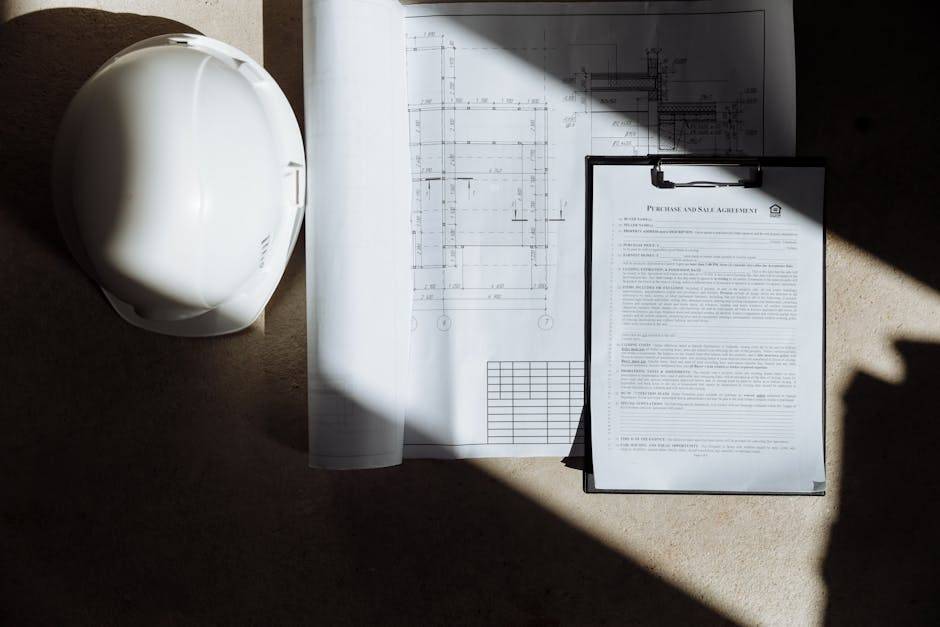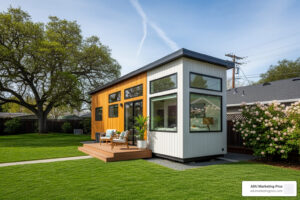Why Pre-Approved ADU Plans Are Changing California’s Housing Crisis
Pre-approved ADU plans are standardized accessory dwelling unit designs that have been pre-reviewed and approved by local building departments to meet all code requirements. Instead of going through lengthy custom design reviews, homeowners can select from these vetted plans to fast-track their ADU permits and construction.
What you need to know about pre-approved ADU plans:
- Free to low-cost: Most California jurisdictions offer plans for $0-$2,000 vs. $5,000-$15,000 for custom designs
- Faster permits: Review times cut by 50% – as little as 5-10 business days vs. 30-60 days
- Reduced fees: Up to 25% savings on plan check fees in cities like Santa Barbara
- Size options: Studio (200 sq ft) to 3-bedroom (1,200 sq ft) configurations available
- Multiple styles: Craftsman, Contemporary, Mediterranean, and Modern designs
- Limited modifications: Mirroring and orientation changes allowed without losing pre-approved status
California’s housing shortage has pushed cities and counties to streamline ADU development. Santa Barbara’s pre-approved program cuts plan review to just 10 business days. San Diego County’s plans come 85% complete, requiring only project-specific details. Los Angeles County offers completely free plans through their Standard Plan Program.
Modern pre-approved plans offer genuine architectural variety while maintaining the speed and cost benefits that make ADU projects financially viable.

Know your pre-approved ADU plans terms:
– adu building plans
– prefab adu los angeles
– studio adu floor plans
What Are Pre-Approved ADU Plans?
Pre-approved ADU plans are complete construction documents that have already been vetted by planning and building departments for compliance with Building, Residential, and Green Codes. Instead of waiting weeks or months wondering if your plans will pass review, you can pick from these pre-checked designs and jump straight to building your ADU.
Licensed architects and engineers create ADU designs that meet all current building codes, then submit these plans to local jurisdictions for advance approval. Once the city or county approves them, any homeowner whose property meets the basic requirements can use these plans.
Los Angeles Department of Building and Safety (LADBS) was one of the first to accept this approach with their Standard Plan Program. The City of Los Angeles actually owns and offers at least one ADU standard plan completely free. If you want to discuss your project with LADBS directly, you can click here for the LADBS appointment link.
Santa Clara County offers both 800 sq ft and 1,200 sq ft plans in multiple architectural styles, complete with CAD files for minor modifications. The county has already done the heavy lifting of reviewing these designs for code compliance, which means dramatically faster approval times and lower costs for homeowners.
How Pre-Approved Differs From Custom & Stock Plans
With custom plans, your architect creates something unique for your lot, then submits it for full review. This can take 30-60 days and cost thousands in plan check fees. Stock plans might seem cheaper upfront, but they’re generic designs that still need full review since your local jurisdiction has never seen them before.
Pre-approved plans give you the best of both worlds. The plan-check for code compliance is already complete, so your building department only needs to verify site-specific details like setbacks, utilities, and zoning requirements. This streamlined review process is exactly why Santa Barbara can turn around permits in 10 days and Concord can issue them in just 5 days.
The trade-off is some flexibility. Most pre-approved plans allow you to mirror the layout, change the orientation, or make minor tweaks. But if you want major structural changes, you’ll trigger a full custom review process and lose those time and cost advantages.
Common Myths About Pre-Approved ADU Plans
The “cookie-cutter” myth is probably the biggest misconception. Modern pre-approved programs offer real variety. Danville provides three distinct architectural styles – Contemporary, Craftsman, and Mediterranean – for each plan size. Orange County offers six different floorplans ranging from cozy 393 square feet to spacious 1,200 square feet.
The quality concern doesn’t hold water either. These plans are designed by the same licensed architects and engineers who create custom designs. They have to meet identical code requirements and often benefit from lessons learned across multiple projects.
The modification myth suggests you’re stuck with exactly what you see, but that’s not true. Most jurisdictions welcome mirroring, orientation changes, and facade modifications. Just remember that major modifications will bump you back into the regular review process.
Benefits & Cost Savings for Homeowners
Pre-approved ADU plans don’t just save you time; they can save you thousands of dollars and get you earning rental income months sooner than traditional routes.
When Santa Barbara rolled out their pre-approved program, they tracked real results: 25% reduction in plan check fees and review times slashed in half. Concord takes speed seriously, promising permit issuance within five working days if your documents are complete. Compare that to the standard 30-60 day timeline most homeowners face.

San Diego County’s pre-approved ADU plans arrive about 85% complete, needing only your site-specific details like property surveys and energy calculations. No more endless revision cycles.
Here’s what really matters: faster permitting means earlier construction starts. And earlier construction means rental income flowing sooner. If your ADU will generate $3,000 per month in rent, every month of delay costs you real money.
Typical Fee & Time Reductions
Santa Clara County offers minimum two-hour plan review fees for unmodified pre-approved plans versus the 10-20 hours typically required for custom plan reviews.
When plan check time costs $150-200 per hour, those savings add up fast. The 25% plan check fee reduction in Santa Barbara often means $500-1,500 back in your pocket. Add in the eliminated design fees (many pre-approved plans cost nothing), and your total upfront savings can reach $5,000-10,000.
Concord’s five-day permit approval versus the standard two-month wait means construction begins nearly two months earlier. For ADU projects generating $2,000-4,000 monthly rental income, this timeline acceleration pays for itself quickly.
Learn more about maximizing your ADU’s potential in our guide on How Big Can an ADU Be in California?
Financial Incentives & Grants
California isn’t just streamlining the process – they’re putting money behind it. The California Housing Finance Agency recently allocated an additional $25 million to their ADU Grant Program after the initial $100 million was exhausted due to overwhelming demand.
These grants provide up to $40,000 specifically for pre-construction costs, including planning and permit fees. That’s exactly the expense category where pre-approved ADU plans help you save the most. Smart homeowners combine grant funding with pre-approved plans for maximum affordability.
Santa Clara County provides a cost calculator at Scientific research on ADU cost to help you budget your entire project.
Pre-approved ADU plans offer the fastest, most affordable path to adding rental income or family housing to your property.
Where You Can Use Pre-Approved ADU Plans in California
California’s pre-approved ADU plans aren’t available everywhere, but most major population centers now offer these streamlined programs. The largest counties – Los Angeles, San Diego, Santa Clara, and Orange County – have all accepted pre-approved plans.
Los Angeles County leads with their free plans available through the EPIC-LA portal. They offer three main sizes: 800 square feet (1 bedroom, 1 bath), 1,000 square feet (2 bedrooms, 1 bath), and 1,200 square feet (3 bedrooms, 1 bath), complete with detailed guidance and site-specific plot plan templates.
San Diego County takes a comprehensive approach with six different standardized plans labeled A through F, ranging from 600 to 1,200 square feet. Their plans come about 85% complete in both PDF and CAD formats.
Santa Clara County focuses on two well-designed sizes: 800 and 1,200 square feet, offered in multiple architectural styles with CAD files for modifications. Changes mean you’ll lose the expedited review status.
Smaller cities have gotten creative too. Santa Barbara offers plans from 406 to 740 square feet in various styles. Concord provides six options ranging from 205 square foot efficiency studios to 847 square foot two-bedroom units.
Size, Types & Styles on the Market

Today’s pre-approved ADU plans offer genuine variety beyond boring box designs.
Studio ADUs typically span 200-400 square feet and represent your most budget-friendly option. One-bedroom units hit the sweet spot between 558-650 square feet. Two-bedroom ADUs range from 748-1,000 square feet. Three-bedroom units typically max out at 1,200 square feet – the legal limit under California’s ADU law.
Architectural styles reflect California’s diverse tastes. Craftsman designs feature classic exposed beams and natural materials. Contemporary styles offer clean lines and natural light. Mediterranean designs with stucco walls and tile roofs suit Southern California, while Farmhouse styles with board-and-batten siding trend in suburban areas.
Some jurisdictions have even accepted prefab factory-built options, which can dramatically speed up construction timelines.
Jurisdictional Restrictions & Exemptions
Not every property can use pre-approved ADU plans, even in cities that offer them.
Hazard zones are typically excluded. Properties in wildland-urban interface areas, special flood hazard zones, or geologic hazard areas usually need full custom review.
Historic districts add complexity. While you might use a pre-approved floor plan, exterior design often needs additional review to maintain neighborhood character.
Multi-unit properties face challenges since many pre-approved programs were designed primarily for single-family homes. Coastal zones require extra attention due to California Coastal Commission oversight.
Site-specific requirements still apply regardless of pre-approval status. You’ll need proper site plans showing setbacks, utilities, and drainage. Title 24 energy calculations are required statewide, and many jurisdictions now mandate solar installations.
For detailed guidance on navigating size and zoning requirements, check out our comprehensive guide on ADU Size Restrictions.
Step-by-Step Process to Select, Modify & Permit a Plan
Getting your pre-approved ADU plan from selection to permit approval typically takes just 2-3 weeks instead of months.
Step 1: Choose and download your plan. Los Angeles County homeowners use the EPIC-LA portal, while Orange County residents steer to MyOCService. Each jurisdiction’s website displays available plans with clear photos and specifications.
Step 2: Site assessment. Verify that your chosen design fits your property. Create a site-specific plot plan showing property boundaries, existing structures, utilities, and exactly where your ADU will sit. Most jurisdictions provide plot plan templates.
Step 3: Document compilation. Instead of waiting for custom architectural drawings, you’re gathering site-specific paperwork. Title 24 energy calculations are required statewide, and many jurisdictions now mandate solar installation plans.
Step 4: Permit submission. Submit entirely online through your local jurisdiction’s portal. Upload documents, pay plan check fees, and receive immediate confirmation.
Step 5: Plan check and approval. Staff only need to verify that your site-specific details work with the already-approved plans. This focused review typically wraps up in 5-10 business days versus 30-60 days for custom designs.
Step 6: Permit issuance and construction. Once approved, pay permit fees and receive the official building permit. Construction can begin immediately.
Can You Modify Pre-Approved ADU Plans? – Keeping “pre-approved ADU plans” Status
You can make several useful modifications without losing the speed and cost benefits of pre-approved status.
Mirroring your floor plan is almost always allowed. If the original design has the kitchen on the left but your lot would work better with it on the right, most jurisdictions let you flip the entire layout.
Orientation changes are typically permitted too. Rotate the entire structure to capture better views, optimize solar exposure, or create more privacy from neighboring properties.
Facade modifications often get approval as well, especially if you’re trying to match your existing home’s architectural style.
However, structural modifications void your pre-approved status. Moving interior walls, changing window sizes, or altering the foundation system usually requires a licensed architect to stamp the modified plans and go through full plan review.
Santa Clara County provides CAD files specifically for modifications but makes it clear that altered plans lose expedited review benefits. The smart move is checking with your jurisdiction before making any changes.
Documents & Checklists You’ll Need

Your document list is much shorter and more predictable than custom projects.
Your site-specific plot plan is absolutely essential. This scaled drawing shows property lines, existing structures, proposed ADU location, setbacks, and utility connections. Most jurisdictions provide templates.
Title 24 CF-1R energy compliance forms are mandatory statewide. These calculations prove your ADU meets California’s energy efficiency standards.
Solar installation plans are becoming the norm. Orange County already mandates third-party solar plans for all ADU applications.
Additional paperwork varies by location: Hold Harmless statements, soils reports for challenging conditions, stormwater management plans for larger projects, and agency referral forms for properties near sensitive areas.
The key to success is using your jurisdiction’s official checklist to ensure complete applications and prevent delays.
For detailed guidance on navigating the broader permitting landscape, our resource on ADU Permits California covers statewide requirements and local variations.
Pre-Approved vs Custom ADU Plans: Which Fits Your Project?
Choosing between pre-approved ADU plans and custom designs doesn’t have to be overwhelming. Think of it this way: pre-approved plans are like buying a well-custom suit off the rack, while custom plans are like having one made from scratch.
When design flexibility matters most, custom plans give you complete creative control. Your architect can work around unusual lot shapes, incorporate specific design requirements, or match your home’s unique architectural details perfectly.
Pre-approved ADU plans offer more flexibility than you’d expect. Modern programs provide multiple sizes, architectural styles, and layout options. You can mirror floor plans, modify facades, and choose from styles ranging from Craftsman to Contemporary. For most typical residential lots, this flexibility covers 80% of what homeowners actually need.
The cost difference is significant. Pre-approved plans typically cost $0-2,000 compared to $5,000-15,000 for custom architectural services. The savings multiply when you factor in reduced plan check fees. Santa Clara County charges just a minimum two-hour review fee for unmodified pre-approved plans, while custom designs face full review costs.
Don’t assume pre-approved is always cheaper. If your lot requires major modifications to make a pre-approved plan work, you might spend more than going custom from the start. Get quotes for both approaches if you’re looking at structural changes or significant site work.
Timeline advantages with pre-approved plans are dramatic. Santa Barbara’s 10-day review process versus 30-60 days for custom plans can accelerate your entire project by months. For investment properties generating $2,000-4,000 monthly rental income, this timeline compression often justifies choosing pre-approved plans.
Both approaches can deliver excellent resale value when executed thoughtfully. Pre-approved plans often incorporate proven design elements and efficient layouts that appeal to broad buyer markets. Custom plans can create unique selling points but may reflect very personal tastes.
Contractors often prefer working with pre-approved plans because familiarity breeds efficiency. Many builders have constructed similar designs before, which reduces their learning curve and can lower your construction costs.
The sweet spot for most homeowners? Pre-approved ADU plans work beautifully for standard residential lots with typical access and utility situations. Custom plans make sense when your site has unusual constraints or very specific design requirements.
For comprehensive guidance on making this decision, explore our detailed resource on ADU Architectural Plans.
Frequently Asked Questions about Pre-Approved ADU Plans
Do pre-approved ADU plans work on every lot?
Pre-approved ADU plans don’t work everywhere. While these plans are designed to fit most standard residential lots, California’s diverse geography and regulations create limitations.
Hazard zones are the biggest deal-breaker. Properties in wildland-urban interface areas, flood plains, or geologic hazard zones require additional engineering analysis that defeats the purpose of streamlined approval.
Historic districts present another hurdle. Even though structural plans might be pre-approved, you’ll still need architectural review to ensure your ADU fits neighborhood character.
Setback requirements can be tricky. Most pre-approved ADU plans assume standard residential setbacks, but every lot is different. Corner lots might have utility easements that prevent placement, or narrow lots might not accommodate the plan’s footprint.
Check your property’s eligibility before falling in love with a specific plan. Santa Clara County offers helpful online tools to verify hazard zone status, and most jurisdictions provide consultation services.
Are the plans really free, and what hidden costs exist?
Yes, many pre-approved ADU plans are genuinely free. Los Angeles County truly offers their plans at no cost through the Standard Plan Program. Santa Clara County, Orange County, and others follow suit because they want to encourage ADU development.
But “free” plans don’t mean free permits. You’re still looking at building permit fees that typically run $5,000-15,000 depending on your project size. Plan check fees are reduced with pre-approved plans, but not eliminated entirely.
Other costs add up: agency referral fees, inspection fees throughout construction, and utility connection fees. Some jurisdictions charge small fees for CAD files if you want modifications, though base plans remain free.
Free plans eliminate the $5,000-15,000 you’d spend on custom architectural services. That’s real money back in your pocket, but it’s not the only money you’ll spend. Always ask for a complete fee schedule upfront.
How long does permitting take with a pre-approved plan?
This is where pre-approved ADU plans really shine. Time savings are dramatic and consistent across California jurisdictions.
Santa Barbara sets the standard with approximately 10 business days for pre-approved plan reviews. Concord promises permit issuance within five working days if your application is complete. Compare that to the 30-60 day timeline of custom plan reviews.
Los Angeles County’s process typically runs 2-4 weeks, depending on whether your project needs agency referrals. San Diego County usually processes their 85% complete plans within 2-3 weeks for straightforward sites.
The catch: incomplete applications kill these time advantages. Submit missing documents or unclear site plans, and you’ll cycle through review rounds that stretch timelines significantly. Use the detailed checklists jurisdictions provide.
Agency referrals add time even with pre-approved ADU plans. If your property needs environmental health approval, fire department sign-off, or utility company coordination, expect additional weeks regardless of your plan’s pre-approved status.
Conclusion
If you’re looking to add an ADU to your California property, pre-approved ADU plans offer the smartest path forward. These vetted designs have revolutionized how homeowners approach accessory dwelling unit development, cutting through the red tape that used to make ADU projects feel overwhelming.
The numbers speak for themselves. Review times slashed by 50%. Fees reduced by up to 25%. Plan costs often completely eliminated. When Santa Barbara homeowners can get permits in 10 days instead of two months, and Concord residents can walk out with permits in just five days, you know something fundamental has changed.
Today’s programs offer everything from cozy 200-square-foot studios perfect for rental income to spacious 1,200-square-foot family units. Whether you prefer Craftsman styling or Contemporary design, there’s likely a pre-approved plan that fits your vision.
The process itself has become refreshingly straightforward. Select your plan, prepare your site documents, submit online, and receive your permit in days rather than months. For most homeowners, especially those building ADUs as investments, this speed advantage far outweighs any design limitations.
Pre-approved plans won’t work on every lot, especially properties in hazard zones or historic districts. But for the vast majority of California homeowners, these plans represent the difference between an ADU project that happens quickly and affordably, and one that gets bogged down in months of reviews and thousands in extra fees.
At ADU Marketing Pros, we’ve watched this change unfold across California’s markets. Based in San Jose, we work with construction and architecture firms who’ve seen how pre-approved ADU plans have opened up opportunities for homeowners who previously couldn’t afford custom design processes. Our specialized marketing solutions help these professionals showcase their expertise in navigating ADU projects.
For homeowners ready to explore their options, check out our guide on Pre-Approved ADU Plans San Jose to see how these programs work in practice and get started with your own ADU project.
California’s housing crisis isn’t going away anytime soon, but pre-approved ADU plans prove that smart policy changes can make a real difference. By removing bureaucratic barriers while maintaining safety standards, these programs are helping thousands of families create affordable housing solutions in their own backyards.




